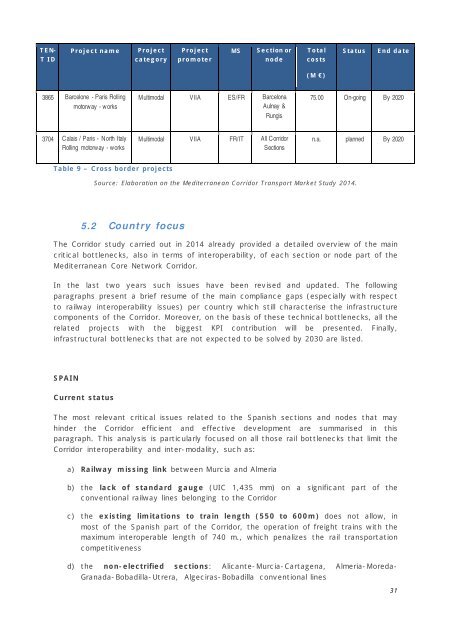Mediterranean
5Lwz6ndOG
5Lwz6ndOG
Create successful ePaper yourself
Turn your PDF publications into a flip-book with our unique Google optimized e-Paper software.
TEN-<br />
T ID<br />
Project name<br />
Project<br />
category<br />
Project<br />
promoter<br />
MS<br />
Section or<br />
node<br />
Total<br />
costs<br />
Status<br />
End date<br />
(M €)<br />
3865 Barcelone - Paris Rolling<br />
motorway - works<br />
Multimodal VIIA ES/FR Barcelona<br />
Aulnay &<br />
Rungis<br />
75.00 On-going By 2020<br />
3704 Calais / Paris - North Italy<br />
Rolling motorway - works<br />
Multimodal VIIA FR/IT All Corridor<br />
Sections<br />
n.a. planned By 2020<br />
Table 9 – Cross border projects<br />
Source: Elaboration on the <strong>Mediterranean</strong> Corridor Transport Market Study 2014.<br />
5.2 Country focus<br />
The Corridor study carried out in 2014 already provided a detailed overview of the main<br />
critical bottlenecks, also in terms of interoperability, of each section or node part of the<br />
<strong>Mediterranean</strong> Core Network Corridor.<br />
In the last two years such issues have been revised and updated. The following<br />
paragraphs present a brief resume of the main compliance gaps (especially with respect<br />
to railway interoperability issues) per country which still characterise the infrastructure<br />
components of the Corridor. Moreover, on the basis of these technical bottlenecks, all the<br />
related projects with the biggest KPI contribution will be presented. Finally,<br />
infrastructural bottlenecks that are not expected to be solved by 2030 are listed.<br />
SPAIN<br />
Current status<br />
The most relevant critical issues related to the Spanish sections and nodes that may<br />
hinder the Corridor efficient and effective development are summarised in this<br />
paragraph. This analysis is particularly focused on all those rail bottlenecks that limit the<br />
Corridor interoperability and inter-modality, such as:<br />
a) Railway missing link between Murcia and Almeria<br />
b) the lack of standard gauge (UIC 1,435 mm) on a significant part of the<br />
conventional railway lines belonging to the Corridor<br />
c) the existing limitations to train length (550 to 600m) does not allow, in<br />
most of the Spanish part of the Corridor, the operation of freight trains with the<br />
maximum interoperable length of 740 m., which penalizes the rail transportation<br />
competitiveness<br />
d) the non-electrified sections: Alicante-Murcia-Cartagena, Almeria-Moreda-<br />
Granada-Bobadilla-Utrera, Algeciras-Bobadilla conventional lines<br />
31



